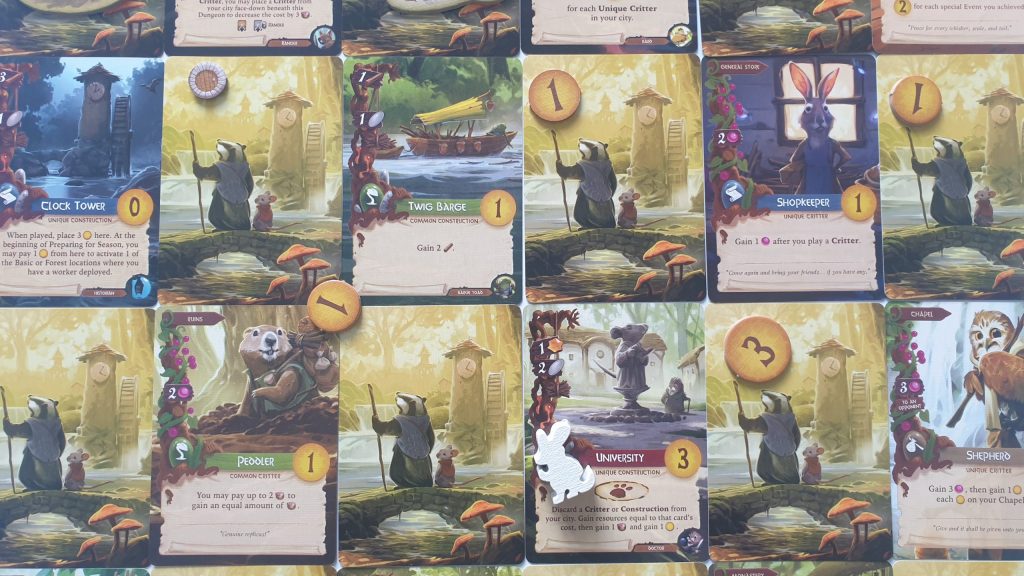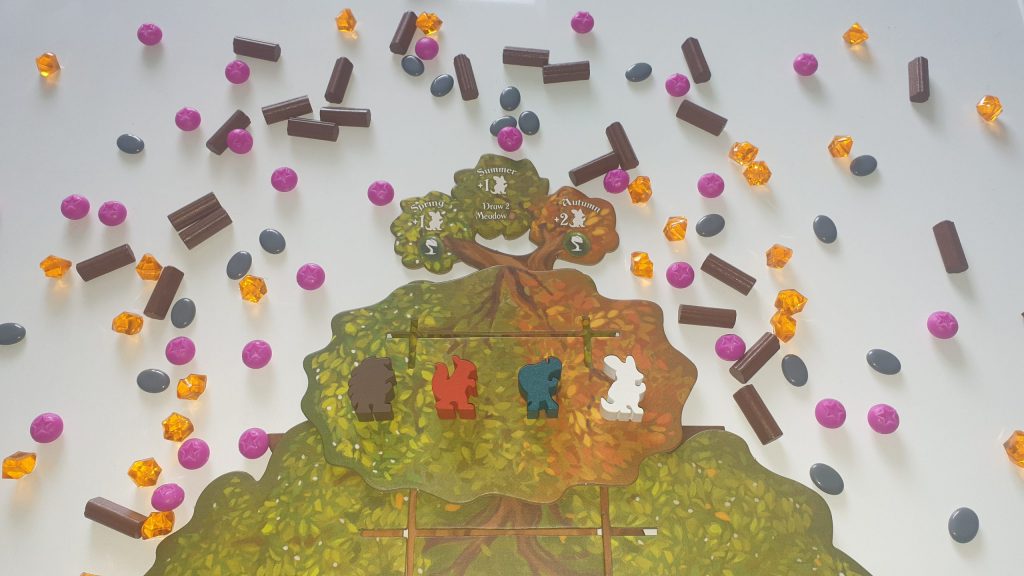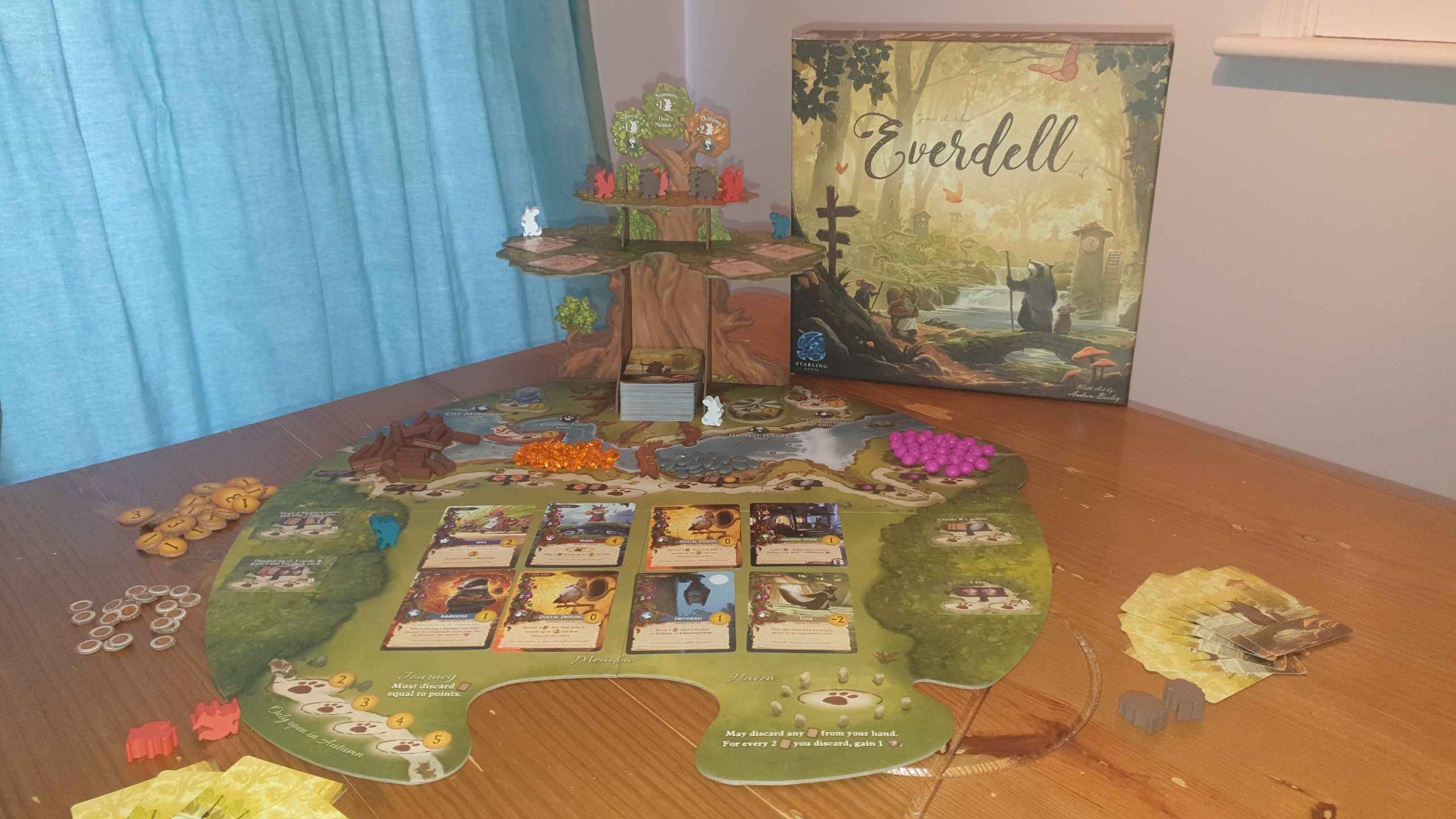Everdell is a fantasy, animal themed worker placement board game from publisher Starling Games. Designed by James A. Wilson, featuring artwork from Andrew Bosley, Cody Jones and Dann May, the game sees 1 – 4 players becoming hedgehogs, squirrels and more. With an aim to build a city beneath the Ever tree, constructions will be erected and critters attracted by berries. However, is a game about twigs, pebbles & critters something to get excited about? Let’s find out!
Setup includes the usual elements, such as adding to the central board the resources, making a market of cards in the meadow and dealing some cards out to players. It also comes with a couple of aspects that inject replayability into the experience, with four randomised forest cards for action spaces and four special event objective cards coming from shuffled decks. A 3D tree is also constructed having on it the aforementioned special events and also most of each player’s workers. Each player starts with only two workers out of a total of six. The four left over for each player are placed on the top shelf of the 3D Ever tree.
Everdell lasts for 4 seasons, before the animals presumably have to hibernate in winter. One of the key concepts of Everdell is that when these seasons end can differ for the players. This results in it being summer for some, while it is still spring for others; as if they were advancing to the next round before the others. In turn, a player’s game can end before everyone else is finished
Each turn a player has the choice of 3 actions: place a worker, play a card or prepare for the upcoming season. The central board, including the randomised forest action spaces, has many spaces to place workers. Some of these can be visited by multiple workers, and some can only be visited by one – being blocked if a worker is there. On their turn the player taking this action simply chooses an available space and places a worker there, performing the indicated action. The majority of the basic worker placement actions gain the player resources or allow them to draw cards from the deck. Some however see the player discard cards or complete event like objectives for having specific things built in their tableau.
Players can instead choose to play a card. Importantly, this can be from their hand or the central meadow. While players have a hard hand limit of 8 cards, with access to meadow cards they technically have a choice from up to 16 cards – reducing the impact of deck based luck. Having cards accessible by all players also increases the interaction between players, as anyone can buy them on their turn – making it a sort of race to secure what you want. Cards can be paid for with resources. Buildings will need pebbles, twigs and/or resin, while critters will cost berries.

Some construction cards allow a player to skip the cost of a specific critter. Each construction can only do this once, with an occupied token placed onto the construction to remind the player. For example, the farm allows the player to freely play either a husband or a wife into their tableau. As well as being split into constructions and critters, cards can also be either common or unique. Whilst not unique in the deck, players can only have one copy of unique cards in their tableau. In contrast a player can have as many of the same common constructions or critters as they wish.
Having only two workers in round one sounds too few for a worker placement game, though much of the game is driven by playing cards. Each card has its own effects. Some are ongoing, seeing points earnt for specific things being built, while others even open up new worker placement spaces – for unique actions. While there is a 15 card limit to the tableau, players don’t always reach this figure – plus, some cards sit outside of a player’s tableau.
A selection of the constructions are marked as production, instantly giving the player the denoted resource. When performing the third action preparing for the next season, in both spring and fall, these production constructions will once again provide the player with the denoted resources. Note, this does not happen when advancing to summer – where players get to take two cards from the meadow for free. When preparing for the next season a player also takes all of their workers back off the board, potentially freeing up worker placement spaces. They will also claim the additional workers for the season they are moving into, until in Fall where they’ll have all 6.
The game continues until all players have finished their final season, and as mentioned this can be at different times. Players will have earnt points for simply playing cards to their tableau, by completing the events and the special event objectives. Points can also be awarded by specific cards or actions. Combining all of their points, the player with the most wins. Ties are split by the events players have earnt otherwise the victory is shared.
There were a few occasions when the bonuses from the special event cards or critter/construction cards weren’t instantly obvious, and needed to be clarified by checking the rulebook. Thankfully, there is an index for the critters and construction cards – describing what they do in detail. Don’t let this rarity put you off though, for the most part though everything is clear and simple, via a blend of text and symbology. The majority of the gameplay comes from what is on the cards, so these being clear helps set the game up for a smooth experience.

Having a lot of the intricacies on the cards is ideal for getting Everdell to the table quickly. The teach is rather short, even if you include examples of how a few cards work. For those that like to hear minimal rules and then learn by playing this is 100% the way Everdell works. For the first game, as new cards come out, the game is slowed down. Everyone will want to know what a card does, and how it could help them to victory, when it enters the meadow.
There are a number of repeats in the deck, so this slow down isn’t to the same extent as with Terraforming Mars, where every card is unique. A good balance between variety and repetition has been struck, with players still eager to grab a card quickly, whilst not bamboozling players with a flood of cards to read. After a game or two this slowness disappears and the streamlined gameplay shines through. At this stage is about when I started wanting an expansion. Whilst not a necessity to drive up variety, players can start to see combos in the deck. Knowing there are expansions which offer new or further combos only makes you want to try them!
Just like the best engine builders, there is a point when you need to stop using workers to create a resource engine and go for points, hoping you have enough resources coming in to allow cards to be purchased. The chaining of occupiable cards helps this and makes turns feel successful – especially when you string a few turns together to pull something off. The deck has a good mixture of somewhat cheap through to expensive cards to play. There are routes to victory via both ends of the spectrum – in a sort of a quantity versus point scoring quality fashion. It’s another way that the gameplay is aided in staying fresh, with players able to go down different routes each game, whilst having their favourite few cards.
From the 3D cardboard tree, across the stunning deck, to the animal meeples, the components ooze quality and help build the theme. The artwork keeps players in the world of foraging mice and postal pigeons. Even the occupied tokens for when a card is used to home a critter is a little round, hobbit like, door token – so it is like you are actually giving that critter a home in the construction. The standout element is surprisingly not the standing tree, it is the resources. These aren’t just cardboard chits, they are silicon like berries, plastic pebbles, wooden twigs and translucent plastic resin. The quality is what you’d expect from a deluxe edition, not a standard retail version.
It isn’t all perfect though, and the biggest grip is Everdell’s biggest component of the lot. The 3D tree looks fantastic, there is no denying that. It gives the game table presence. It also makes it hard for all players to see all of the special event cards. To make matters worse, depending on the seating situation, it can block a player’s view of a good chunk of the board. Due to this, and that it needs to be constructed and dismantled every game, most of it often stays in the box – with only the tree branch-like shelves used next to the board. They allow there to be a zone for the special events and future season meeples, on top of having the main board clearly visible by everyone.
Everdell uses the gimmicky 3D Ever tree to pull players in. They stay for the choice filled, streamlined gameplay. The first playthrough opens players’ eyes to how much better they could have done: what they should never have discarded and how they could have obtained those few berries more for an extra critter. With many routes to victory Everdell is a worker placement game that you’ll want to instantly play again, which is more than possible given the 1 hour play time. It’s got the gameplay players look for in a light worker placement game and a presentation expected of a fancy deluxe version. For those reasons, Everdell will keep hitting the table time and time again!
(Editor’s Note: Everdell was provided to us by Asmodee for the review. The game is currently available from local board game stores, some of which are running dropoff services, find your local store here.)

